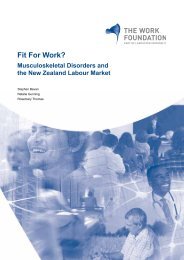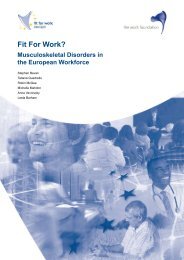FfW Bulgarian report (English language) - Fit for Work Europe
FfW Bulgarian report (English language) - Fit for Work Europe
FfW Bulgarian report (English language) - Fit for Work Europe
You also want an ePaper? Increase the reach of your titles
YUMPU automatically turns print PDFs into web optimized ePapers that Google loves.
Interventions<br />
54<br />
Some critics of the biopsychosocial model (McLaren, 2006) have focused on this last point,<br />
highlighting concerns that this approach may encourage or ‘permit’ helplessness in some<br />
patients or that, in other circumstances, it may alienate patients who feel that they are being told<br />
that their condition is ‘all in the mind’. Clearly, care must be taken in the way that clinicians and<br />
others mitigate these risks, but the balance of the literature – including country-specific evidence<br />
– is strongly in support of the biopsychosocial model and its role in in<strong>for</strong>ming the management<br />
of MSDs in both clinical and occupational settings (Smyth, Stone, Hurewitz, and Kaell, 1999;<br />
Carter, McNeil and Vowles, 2002; Zampolini, Bernardinello, and Tesio, 2007). Indeed, it <strong>for</strong>ms<br />
the basis of the World Health Organisation’s International Classification of Functioning, Disability<br />
and Health (ICF) which has been widely embraced as an authoritative guide <strong>for</strong> vocational<br />
rehabilitation (WHO, 2001).<br />
An example of successful intervention to reduce sickness absence based on the<br />
biopsychosocial model is provided by Ektor-Andersen, Ingvarsson, Kullendorff and Ørbæk<br />
(2008). In their study Ektor-Andersen et al. developed a tool based on the Cognitive Behavioural<br />
Theory (CBT) method of functional behaviour analysis. Factors <strong>for</strong> long-term sick leave due<br />
to musculoskeletal symptoms were identified in four different domains: the community, the<br />
workplace, the family/spare time and the health care system. Care-seekers were examined<br />
by each member of the interdisciplinary team and risk factors were identified and classified as<br />
stable or dynamic. Dynamic factors were the ones the care-seekers and the team agreed to<br />
intervene on. Some of these interventions involved CBT sessions and others focused more<br />
on physiotherapy which were then administered <strong>for</strong> a year. Results from the study show that<br />
this type of intervention is effective in significantly reducing sick leave and social security<br />
expenditure only four months after the intervention started. Although the cost-benefit analysis<br />
presented by Ektor-Andersen et al. (2008) underestimates the total savings by taking into<br />
account social security costs only, the costs of this type of intervention are balanced out by the<br />
reduced costs in sickness allowance during the first year.<br />
In contrast to a lot of other <strong>Europe</strong>an countries, research published by academics at the<br />
National Centre <strong>for</strong> Public Health (eg Tzenova and Velkova, 2008) and the Institute of<br />
Psychology at the <strong>Bulgarian</strong> Academy of Science (eg Rusinova et al., 2007) demonstrates that<br />
there is an understanding of the biopsychosocial model amongst academics in the country.<br />
Nevertheless, understanding the link between the multi-faceted factors of impact is only the<br />
starting point to changing policy and practice. Despite providing employers with knowledge to<br />
reduce the impact of MSDs on employees through managing psychosocial factors, so far there<br />
is no evidence that measures taken to mitigate the workplace risk have been implemented,<br />
<strong>Fit</strong> For <strong>Work</strong>?







